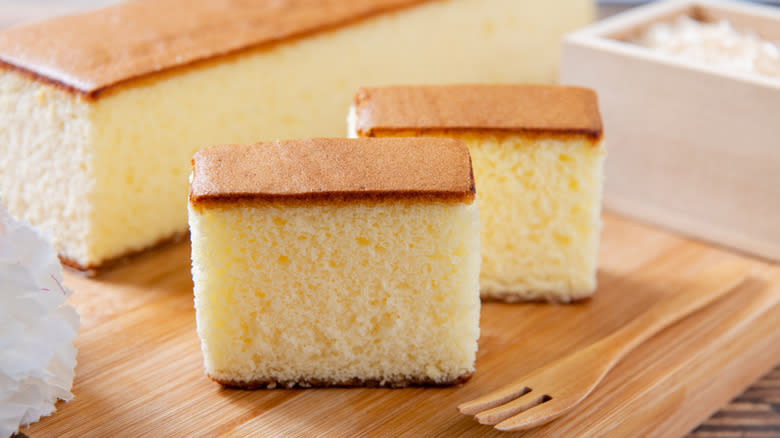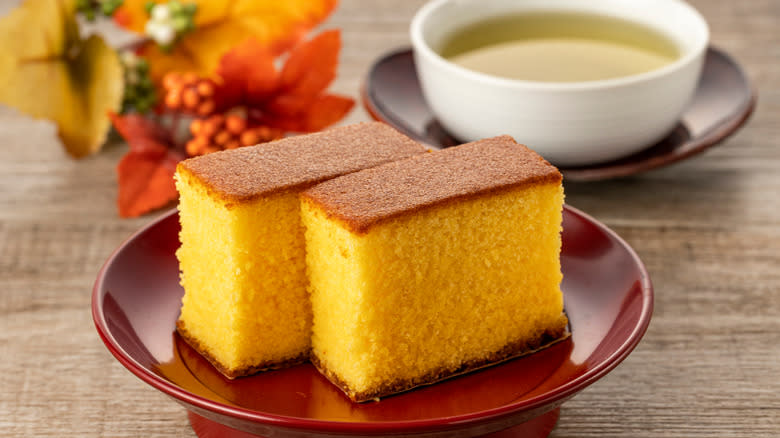What Makes Japanese Castella Cake So Unique?

When most of us think of Japanese desserts, we think of things like matcha green tea ice cream and Japanese mochi. However, this is just scratching the surface in terms of what sweet treats are served in this country. Besides these, another popular treat that people enjoy in Japan is something called castella cake, or Kasutera.
Castella cake is a type of sponge cake, except unlike the standard sponges we enjoy in the United States, this dish is unique in that it has a bouncy, moist texture. Additionally, this cake is slow-baked in a wooden cake pan to help get it that unique, smooth texture. The cake is easily recognizable by its golden brown top and fluffy yellow interior.
Besides these properties that make Japanese castella cake unique, here's what goes into this Japanese confection. Plus, here's a look at the fascinating history of Japanese castella cake and how it came to be.
Read more: Cake Hacks Every Baker Will Wish They Knew Sooner
What Goes Into A Castella Cake, And How To Make It?

Japanese castella cake consists of only a few ingredients — flour, sugar, water, honey, and eggs. Unlike a traditional sponge cake in the United States, there's no baking soda or baking powder, and instead, it's the eggs that give the cake its fluffy texture. There's also no oil or butter in this recipe, unlike many American baked goods recipes.
If you want to make a castella cake for yourself, the first thing to do is to preheat your oven to 320 degrees Fahrenheit, or 295 degrees Fahrenheit if you're using a convection oven. Then, fit parchment paper into two loaf pans and set them aside. To start baking, sift 1 ⅔ cups of bread flour into a bowl. Set this aside and mix 2 ½ tablespoons of warm water with ⅓ cup of honey. Set this aside and beat 6 large eggs with an electric mixer until they're fluffy, and then add 1 cup of sugar. Beat the mixture until it's pale yellow and quadrupled in volume. Next, mix in the water and honey mixture slowly. Then, add the flour one-third at a time into the batter until it's combined. Divide the mixture into your loaf pans and bake for 35 to 40 minutes on the middle rack.
When your cakes come out of the oven, top them with a mixture of 1 tablespoon of honey and ½ tablespoon of warm water. Then wrap them in plastic wrap and refrigerate them for 12 hours before serving!
The Unique Backstory Of The Japanese Castella Cake

The ingredients and preparation method aren't the only unique things about Japanese castella cake. The history of this treat is one-of-a-kind, too. Although castella cake is a Japanese confection, its history is actually tied to another country — Portugal.
Back in the 16th century, Portuguese merchants came to the Japanese port of Nagasaki to trade and serve as missionaries. During this period, the merchants brought many different goods, including castella cake. At the time, the Portuguese called the cake Pão de Ló or Pão de Castela, which is how the cake became known as castella cake. Castella isn't a Japanese word, however, and locally, the cake is also known as Kasutera.
Castella cake was eventually adapted to fit local preferences, and today it is quite popular throughout Japan. You can even find it in a variety of flavors, such as chocolate or green tea. Whether you choose to enjoy the classic castella cake or you go for one of these more modern twists, take a bite out of this unique sponge and enjoy a lasting Japanese tradition.
Read the original article on Daily Meal.

